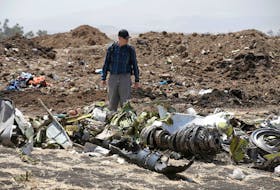The amount of carbon spewed into the environment by fishing boats has jumped over the decades, a new study indicates.
Researchers from Dalhousie University and the University of British Columbia, using 2011 statistics, estimate that the world’s fishing fleets burned 40 billion litres of fuel and emitted 179 million tonnes of carbon dioxide.
That represents a jump in emissions of about 28 per cent compared to 1990, and it was driven mostly by increased harvests from fuel-intensive crustacean fisheries such as lobster and snow crab.
“If you think about a trap fishery like snow crab or lobster, you’re dealing with ultimately a lot of travel time for not a lot of landing,” said study co-author Peter Tyedmers in an interview Tuesday from his office at Dalhousie’s resource and environmental studies department.
“It doesn’t compare with what you can do with a purse seiner when you’re targeting tuna or targeting mackerel. It’s so distributed across so many owner operators, right? But many people have known for a while that certain fisheries burnmore fuel than other fisheries, and sometimes a lot more fuel, relative to the live weight of what they end up landing.”
The study, led by Robert Parker, a postdoctoral fellow at the University of British Columbia and a former student of Tyedmers, found that five countries were responsible for almost half of the total emissions in 2011: China, Indonesia, Vietnam, the United States and Japan.
“They are big fishing nations. They land lots of biomass,” Tyedmers noted.
While the biggest polluters didn’t surprise him, he was taken aback by the amount that carbon emissions has increased over the decades.
“I was surprised,” he said. “I would have generally thought we wouldn’t have seen an overall much of a growth in global fisheries. . . . Even though the total scale of global fish landings is largely unchanged over that time period, when you are increasingly reliant on a very fuel-intensive sub-part of the global fishing fleet, you end up burning more fuel.”
Canada’s overall contribution to fisheries emissions has dropped since 1990, Parker said in an email from his UBC office.
In 2011, Canadian fisheries made up one per cent of the global fishing catch, and also one per cent of global fishing emissions, the researchers found.
“The Canadian fishing fleet is very close to average in terms of emissions per tonne of fish or shellfish landed,” Parker said. “While total fisheries production and emissions in Canada have decreased since 1990, the average impact per tonne has remained the same. We estimated that roughly half of Canada’s fishing emissions in 2011 came from crustacean fisheries, which made up around a third of the catch.”
While one per cent of global emissions may not seem significant, Tyedmers said the industry should be talking about ways to reduce its environmental footprint, even if it’s as simple as reducing the number of trips to check traps.
When it comes to greenhouse gas emissions, “it is just an unrelenting upward slope,” he said. “No matter what sector that people can point to that says, oh we’re decarbonizing here, we’re doing that there, . . . we’re really not putting a dent in any of this. And fisheries is an example.”









